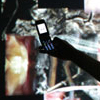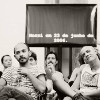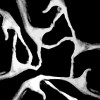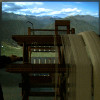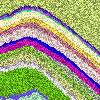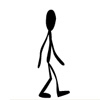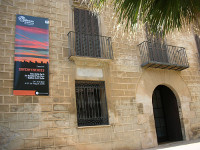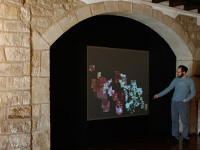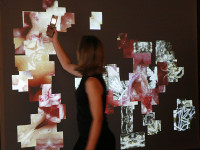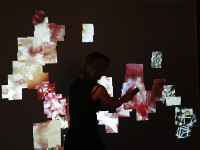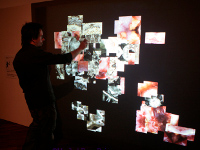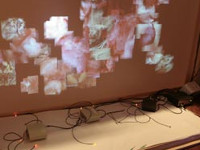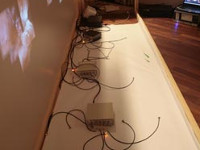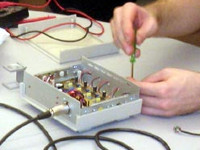[collaborations]
Interferences
An art installation by Matteo Sisti Sette and Maribel Pozo Ruiz
Interferences is an installation that reacts to electromagnetic waves emitted by mobile phones. It consists of a back-projection screen about 2 by 1.5 meters in size, where a simulated artificial life system is displayed, resembling some sort of organic life form. Electromagnetic waves, like those emitted by the visitors' mobile phones, are detected by the installation and provoke visible and audible alterations in the organism's aspect and behavior.
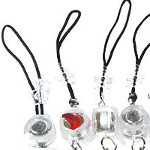 The electromagnetic wave sensors, placed behind the screen, were created by hacking a few cheap "cellphone signal activated flashing LED" keyrings,
which in those years used to be popular and were easily found in most chinese bazaars here in Europe. These keyrings would start blinking when exposed to cell phone signal waves. Each sensor is made of several hacked keyrings and a custom circuit board. A Basic Stamp microcontroller is used to collect the measurements from the sensors and send them to the computer. Héctor López manufactured professional circuit boards (with boxes, connectors, etc.) based on my schematics.
The electromagnetic wave sensors, placed behind the screen, were created by hacking a few cheap "cellphone signal activated flashing LED" keyrings,
which in those years used to be popular and were easily found in most chinese bazaars here in Europe. These keyrings would start blinking when exposed to cell phone signal waves. Each sensor is made of several hacked keyrings and a custom circuit board. A Basic Stamp microcontroller is used to collect the measurements from the sensors and send them to the computer. Héctor López manufactured professional circuit boards (with boxes, connectors, etc.) based on my schematics.
The software running the artificial life simulation and generating the projected image is written in Processing. The audio part is written in Pure Data, receiving data from Processing over TCP/IP. The artificial life system is not very complex. It is made of "cells" which are born, reproduce themselves and die. Cells are visualized as simple geometric shapes (each cell is made of two partially overlapping squares), each one phisically attached to its parent cell in a tree structure. These shapes are filled with textures made of photos. By mixing algorithmic geometries with photographic textures, we try to pursue a kind of aesthetic that is not the one typically associated with artificial life simulations. The emphasis is not in visualizing a complex system in order to learn about its behavior, but rather to use it as a means to create an aesthetic result.
When electromagnetic waves are detected, cells start to mutate, with a probability that increases with the strength of the radiation. Several sensors are placed behind the screen, so regions of the image where the radiation is stronger are likely to exhibit more mutations. Mutated cells have different appearence and behavioral parameters (such as avarage size, life expectancy, speed of movement, ability to reproduce...) and are textured with a different set of photographs.
Interferences was exhibited in 2006 at Caixaforum Barcelona as part of a group exhibition of the artist collective MAD04, and in 2008 individually at Museu de l'Hospitalet.

